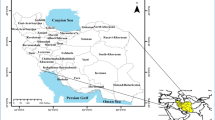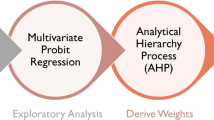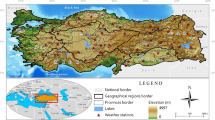Abstract
In this article we develop a concept for the assessment of state’s susceptibility to drought based on a political science perspective. Different sources of capacities and sensitivities need to be taken into account to assess the overall susceptibility of states as political systems. We argue that the overall susceptibility of a society depends on an interplay of state capacity and readiness as main elements of political susceptibility, wealth and economic sensitivity as elements of economic susceptibility and the degree of social integration. To transform the conceptual model into a susceptibility assessment we developed an inference model in order to generate quantitative indices. For this purpose we apply fuzzy set theory using data from our case study regions, namely Andhra Pradesh (India), the Volga region (Russia) and (Southern) Portugal. The resulting computed trends for Portugal suggest that the society will be able to deal even with severe natural conditions due to existing political, economic, and social conditions. The assessment results for the Indian and Russian case study regions, in contrast, give reason for precaution since the occurrence of drought-induced crisis events seems much more likely in the light of more crucial, overall conditions, namely lower degrees of state capacity and readiness as well as, in the case of India, a high economic susceptibility. However, further improvements are possible given the improved availability of data and the integration of more qualitative information. Additionally, the expansion to further case study regions could help validate the overall concept.



Similar content being viewed by others
References
Acosta-Michlik L, Kumar K, Klein RJT, Campe S (2008) Assessing state susceptibility from a socio-economic perspective for the development and application of Security Diagrams. Reg Environ Change
Acosta-Micjlik L, Eierdanz F, Alacmo J, Krömker D, Galli F, Klein RJT et al (2006) An empircal application of the security diagram to assess the vulnerability of india to climate stress. Erde 137(3):199–222
Alcamo J, Endejan M (2001) The security diagram: an approach to quantifying global environmental security. In: Petzold-Bradley E, Carius A, Vincze A (eds) Responding to environmental conflicts: implications for theory and practice. NATO ASI series. Kluwer, Dordrecht, pp 133–147
Alcamo J, Carius A, Eierdanz F, Klein RJT, Krömker D, Acosta-Michlik L et al (2008) Vulnerability to drought: quantifying and comparing different disciplinary perspectives. Reg Environ Change
Arbetman M, Kugler J (1997) Political capacity and economic behavior. Westview Press, Boulder
Benson C (1998) The cost of disasters. In: IDNDR (eds) Development at risk? Natural disasters and the third world. Oxford Centre for Disaster Studies
Blaikie PM, Brookfield H (eds) (1987) Land degradation and society. Methuen, London/New York
Berkes F (1999) Sacred ecology. Traditional ecological knowledge and resource management. Taylor & Francis, Philadelphia
Carnegie Commission on Preventing Deadly Conflict (1997) Final report. Carnegie Commission on Preventing Deadly Conflict, Washington, DC
Center for Global Development (2007) Does the IMF constrain health spending in poor countries? Evidence and an agenda for action. Center for Global Development, Washington, DC
Chua A (2003) World on fire. How exporting free markets democracy breeds ethnic hatred and global instability. Doubleday, New York
Davis T (2006) A failure of initiative. Final report of the select Bipartisan Committee to investigate the preparation for and response to Hurricane Katrina, 10 October, 2007. http://www.katrina.house.gov/index.htm
Diamond J (2005) Collapse. How societies choose to fail or succeed. Viking, New York
Eberwein WD, Chojnacki S (2001) Scientific necessity and political utility. A comparsion of data on violent conflicts. Wissenschaftszentrum für Sozialforschung, Berlin
Eierdanz F, Alcamo J, Acosta-Michlik L, Krömker D, Tänzler D (2008) Using fuzzy set theory to address the uncertainty of susceptibility to drought. Reg Environ Change
Fauvelle-Aymar C (1999) The political and tax capacity of government in developing countries. Kyklos 52(3):391–413. doi:10.1111/j.1467-6435.1999.tb00224.x
Freedom House (2001) Press freedom survey 2001. Washington, DC
Fund for Peace 2007, Failed State Index 2007. 30 August, 2007, Available at http://www.fundforpeace.org
GAVI (2000) Immunize every child. GAVI Strategy for sustainable immunization services. Global Alliance for Vaccines and Immunization, Geneva
Grindle MS (1996) Challenging the state: crisis and innovation in Latin America and Africa. Cambridge Studies in Comparative Politics. Cambridge University Press, Cambridge
Grindle MS (1997) Getting good government. Capacity building in the public sectors of developing countries. Havard University Press, Boston
Haug S (1997) Soziales Kapital. Ein kritischer Überblick über den aktuellen Forschungsstand. Mannheimer Zentrum für Europäische Sozialforschung, Arbeitspapiere Arbeitsbereich II/15. Mannheimer Zentrum für Europäische Sozialforschung, Mannheim
Homer-Dixon T (1994) Environmental scarcities and violent conflict: evidence from cases. Int Secur 19(1):5–40. doi:10.2307/2539147
IPCC (1996) Climate change 1995. Impacts, adaptations and mitigation of climate change. Contributions of working group II to the second assessment report of the intergovernmental panel on climate change. Cambridge University Press, Cambridge
IPCC (2001) Climate change 2001: impacts, adaptation, and vulnerability. summary for policymakers. A report of working group II of the intergovernmental panel on climate change. Cambridge University Press, Cambridge
IPCC (2007) Climate change 2007: impacts, adaptation and vulnerability. Working group II contribution to the intergovernmental panel on climate change fourth assessment report. Summary for policymakers. 30 July 2007. Available at http://www.ipcc.ch/SPM13apr07.pdf
Jaggers K, Gurr TR (1995) Tracking democracy’s third wave with the polity III data. J Peace Res 32:469–482. doi:10.1177/0022343395032004007
Jenkins CJ, Bond D (2001) Conflict carrying capacity, political crisis, and re-construction: a framework for the early warning of political system vulnerability. J Conflict Resolut 45:3–31. doi:10.1177/0022002701045001001
Krömker D, Eierdanz F, Stolberg A (2008) Susceptibility from agent based perspective: the protection-capacity model. Reg Environ Change
Lambsdorff JG (2001) How corruption in government affects public welfare—a review of theories. Discussion Paper 9. Center for Globalization and Europeanization of the Economy, Göttingen
Mann M (2004) The dark side of democracy. Explaining ethnic cleansing. Cambridge University Press, Cambridge
Mitchell J (1998) Protecting development. Integrating disasters and development. In: IDNDR (eds) Development at risk? Natural disasters and the third world. Oxford Centre for Disaster Studies
Munich Re (2004) Topics geo. Jahresrückblick Naturkatastrophen 2003, München
Pfahl S, Tänzler D (2005) Bestandsaufnahme und Bewertung von Capacity Development-Maßnahmen im Bereich der internationalen Klimapolitik. Studie im Auftrag des DIE. Deutsches Institut für Entwicklungspolitik, Bonn
Pfetsch FR, Rohloff C (2000) KOSIMO: a databank on political conflict. J Peace Res 37:379–389. doi:10.1177/0022343300037003006
Prescott-Allen R (2001) The well being of nations. Island Press, Washington
Putnam RD (2000) Bowling alone the collapse and revival of American community. Simon & Schuster, New York
Rössel J (2002) Die Qualität von demokratischen Regimen. Zur Erklärung der politischen Performanz in Italien und Indien durch Robert Putnam und Patrick Heller. Polit Vierteljahresschr 43:302–329. doi:10.1007/s11615-002-0034-4
Rotberg RI (2007) The challenge of weak, failing and collapsed states. In: Crocker CA, Hampson, FO, Aall P (eds) Leashing the dogs of war. United States Institute for Peace, Washington, DC, pp 83–94
Schneckener U (ed) (2004) States at risk. Fragile Staatlichkeit als Sicherheits- und Entwicklungsproblem. Stiftung Wissenschaft und Politik, Berlin
Schneckener U (2007) Rankings und Indizes: Welche Staaten gelten als fragil? 29 August, 2007. http://www.swp-berlin.org/de/common/get_document.php?asset_id=3832
Schwartz J (2003) The impact of state capacity on enforcement of environmental policies: the case of China. J Environ Dev 12(1):50–81. doi:10.1177/1070496502250438
Sen A (1981) Poverty and famines: an essay on entitlement and deprivation. Oxford University Press, Oxford
Sen A (1999) Democracy as a universal value. J Democracy 10(3):3–17. doi:10.1353/jod.1999.0055
Skocpol T (1999) Bringing the state back in: strategies of analysis in current research. In: Evans P, Rueschemeyer D, Skocpol T (eds) Bringing the state back in. Cambridge University Press, New York, pp 3–43
Skoufias E (2003) Economic crisis and natural disasters: coping strategies and policy implications. World Dev 31:1087–1102. doi:10.1016/S0305-750X(03)00069-X
State Capacity Project (1997) The project on environmental scarcities, state capacity, and civil violence: American academy of arts, peace and conflict studies program at University College of the University of Toronto
State Failure Task Force (2000) State failure task force report: phase III findings. Available at http://www.cidcm.umd.edu/inscr/stfail/SFTF%20Phase%20III%20Report%20Final.pdf
Tänzler D, Feil M, Krömker D, Eierdanz F (2008) The challenge of validating vulnerability estimates—the option of media content analysis for identifying drought-related crises. Reg Environ Change
Taylor CL, Jodice DA (1983) world handbook of political and social indicators. Volume 1: Cross-national attributes and rates of change, 3rd edn. Yale University Press, New Haven
TERI (2003) Coping with global change: vulnerability and adaptation in Indian agriculture. The Energy Research Institute, New Delhi
Twigg J (1998) Disasters, development and vulnerability. In: IDNDR (eds) Development at risk? Natural disasters and the third world. Oxford Centre for Disaster Studies, pp 2–7
UNDP (2003) Human Development Report 2003. Millennium development goals: a compact among nations to end human poverty. Oxford University Press, New York
UNEP (2007) Sudan: post-conflict environmental assessment. Verfügbar unter. 31 August, 2007. http://www.unep.org/sudan/
UNESC (United Nations Economic and Social Council) (1998) Promoting social integration and participation of all people, including disadvantaged and vulnerable groups and persons. Report of the Secretary General. E/CN.5/1998/2
USAID (2006) Fragile states indicators a supplement to the country analytical template. US Agency for International Development, Washington, DC
Vanhanen T (2000) A new dataset for measuring democracy, 1810–1998. J Peace Res 37(2):251–265. doi:10.1177/0022343300037002008
Walker PA (2005) Political ecology: where is the ecology? Prog Hum Geogr 29(1):73–82. doi:10.1191/0309132505ph530pr
Watts MJ (1983) Silent violence: food, famine and peasantry in northern Nigeria. University of California Press, Berkeley
WBGU (2007) Welt im Wandel: Sicherheitsrisiko Klimawandel. WBGU, Berlin
World Bank (1999) World development indicators 1999. World Bank, Washington, DC
World Bank (2003) World Development Report 2003. Sustainable development in a dynamic world. Transforming institutions, growth, and quality of life. World Bank/Oxford University Press, New York
World Health Organization (1981) Global strategy for health for all by the year 2000. World Health Organization, Geneva
World Health Organization (1999) Health 21. The health for all policy framework for the WHO European region. World Health Organization, Regional Office for Europe, Copenhagen
World Summit for Social Development, WSSD (1995) Copenhagen declaration on social development. Available at http://www.un.org/esa/socdev/wssd/documents/index.html
Zimmerer KS, Bassett TJ (2003) Political ecology: an integrative approach to geography and environment-development studies. Guilford Press, New York
Author information
Authors and Affiliations
Corresponding author
Rights and permissions
About this article
Cite this article
Taenzler, D., Carius, A. & Maas, A. Assessing the susceptibility of societies to droughts: a political science perspective. Reg Environ Change 8, 161–172 (2008). https://doi.org/10.1007/s10113-008-0067-3
Received:
Accepted:
Published:
Issue Date:
DOI: https://doi.org/10.1007/s10113-008-0067-3




